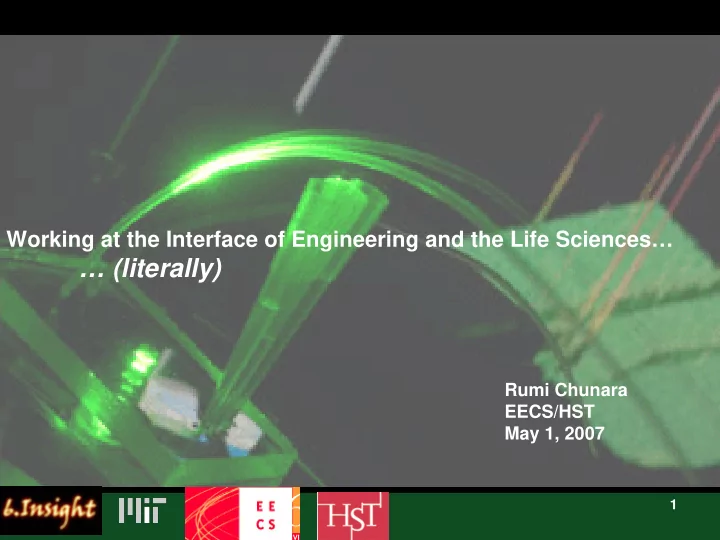

Working at the Interface of Engineering and the Life Sciences… … (literally) Rumi Chunara EECS/HST May 1, 2007 1
Acknowledgements • Manalis Lab: Prof. Scott Manalis, all graduate students, undergrads and post- docs • Prof. J. Han: graphics 2
Engineering “Scientists investigate that which already is; engineers create that which has never been.” –Albert Einstein “Engineers like to solve problems. If there are no problems handily available, they will create their own problems.” –Scott Adams 3
Interfacing with other Fields Engineering tools: modelling, largescale computational analysis, device design Biological systems: networks, systems, feedback pathways 4
Probing Biological Systems What feature size must we achieve in engineering in order to be able to probe biological systems? 5
Biological Sensing Common Laboratory Techniques: • Fluorescence • Spectrophotometry • Gene Chips There is lots of information in biological pathways – need a plethora of experiments to understand and quantify 6
Our Lab • Microfabricated devices for molecular sensing • Sensing by mass or charge • Applications: studying properties of specific cell/molecule types, identification of pathogenic cells, specific molecular markers 7
8 MOSCAP
Field Effect Sensors SiO 2 depletion width + + + + + + + + + + + + + + + + + + + + + + + + + + + + + + + + + + + + + + + + + + + + + + + + + + + + + + + Si + + + + + + + + + + + + + + + 9
Device Schematic & Readout voltage amp PC electrolyte lock-in amp current amplifier p-type n++ p++ n-type 10
11 Fabricated Device
Charge-based Measurements Real-time measurement of Heparin: a heavily charged molecule involved in blood clotting 12 10 surface potential (mV) 8 4 2 surface potential (mV) 6 0 -2 -4 4 -6 -8 -10 2 -12 -14 0 -16 0 5 10 15 20 25 time (min) -2 0 5 10 15 20 25 time (min) 12
Clinical “Bias” Point Output Potential Vs. Output Potential Vs. Concentration of Heparin Input Potential (MOSFET) (FET sensor) 13
Mass sensing • Mass of items of interest • Incorporate techniques so that only measuring items of interest, or enhance mass of items of interest • Mass is an obvious way to measure. Not all biological items are charged 14
15 SMR – Detection Principle
16 Reactive Ion Etching Buffer Oxide Etching Thermal Oxidation Anodic Bonding Fabrication
17 Transduction of Signal: Readout Capacitive Resistive Optical
18 Transducing the signal Detection Schemes:
19 Applications: Sensing Bacteria Peak Count (%)
Applications: Red Blood Cell Weighing Normalized Human Red Blood Cell Mass Histogram 1.2 N=3 ~125 pg 1 0.8 0.6 Count 0.4 0.2 0 ~100 pg ~150 pg -0.2 -10 0 10 20 30 40 50 60 70 80 Change in Frequency (Hz) 20
21 Application: Antibody Detection Frequency Shift Vs. Molecular Concentration
Benefits of Portability Using engineering we can make devices that are sensitive, easy to use, inexpensive and can be used in rural settings. A health care centre in Laare, Kenya 22
Interfacing devices to external world • Noise • Small signals • Keeping actuation/measured signals separate (coupling) • Materials compatible with other systems (oxidation, fluid) • Cost 23
Biosensors: what are they for? • Diagnostics (inside and outside laboratory) • Small volumes • Scalability, making more measurements to understand biology • Point of care devices • Personalized medicine 24
Helpful Classes Intro. EECS 6.002, 6.003 6.011, 6.012, 6.013 Quantitative Biological Systems 6.021J, 6.023J, 6.561J Lab in Microscale Engineering 6.07J Advanced Device/Electronics 6.777, 6.376 25
Groups at MIT and Beyond S. Manalis (BE/ME) M. Schmidt (EECS) J. Voldman (EECS - RLE) S. Bhatia (EECS/HST) J. Han (EECS - RLE) S. Amarasinghe (EECS – CSAIL) T. Thorsen (ME) D. Freeman (EECS) Analog Devices, Becton Dickinson and Company, Affymetrix 26
Recommend
More recommend